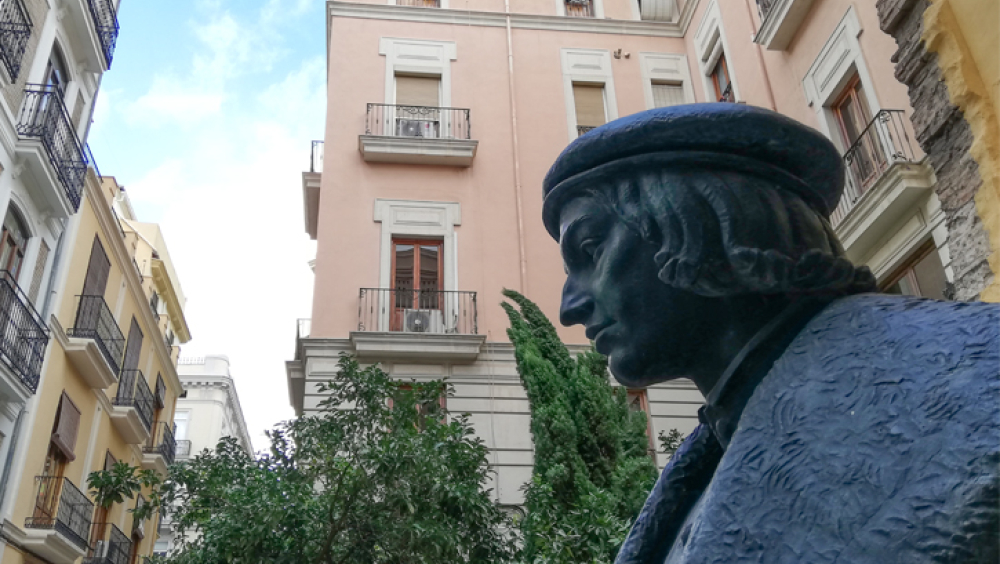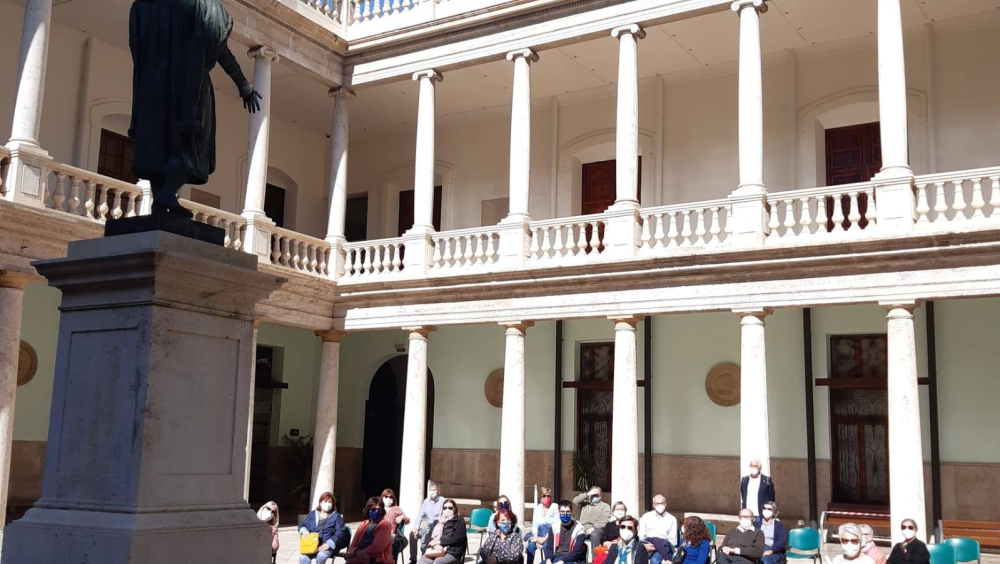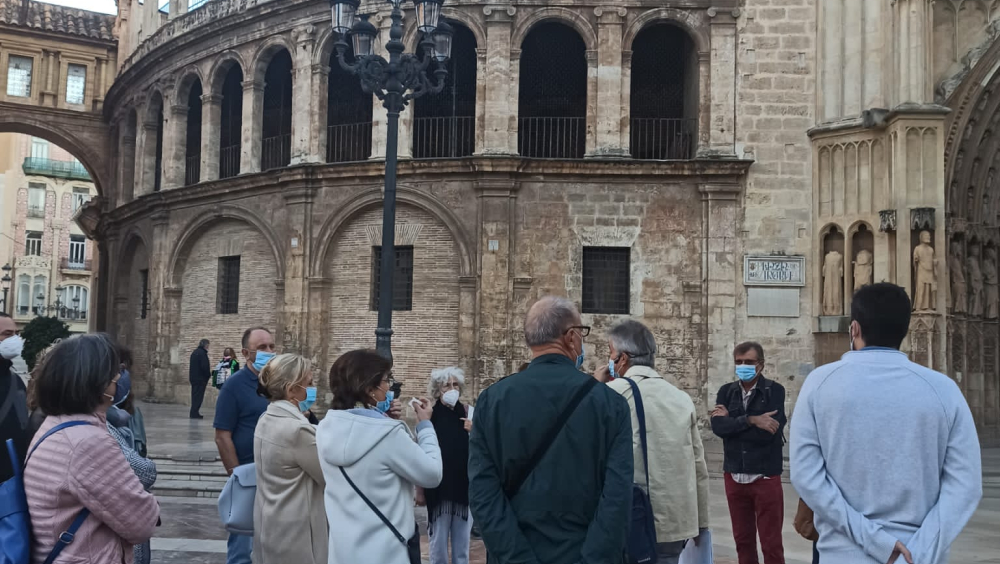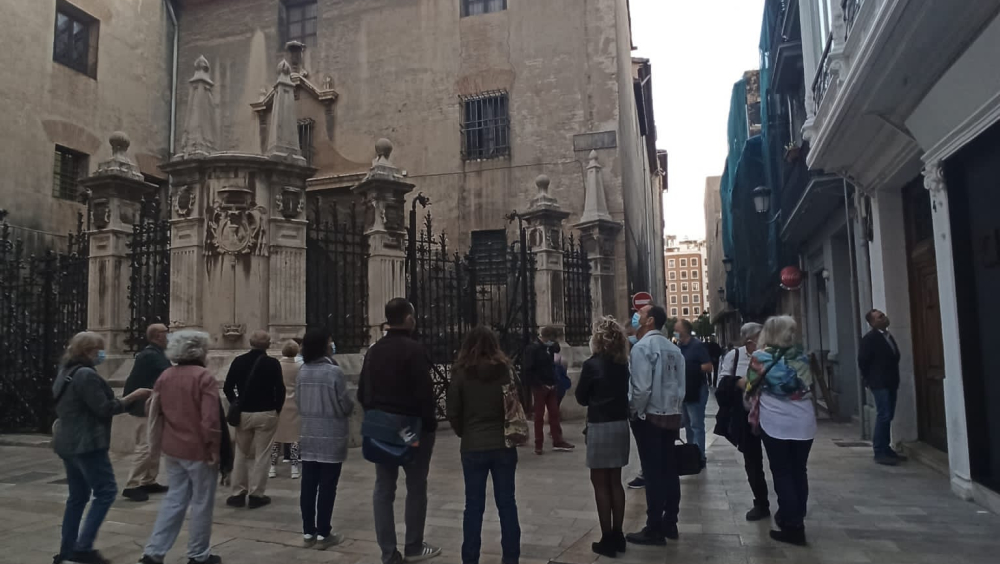A walk through the Valencia of the humanist Luis Vives
Juan Luis Vives (Valencia, 1492-Brujas, 1540) is recognised as one of the great European humanists of the 16th century, along with Erasmus of Rotterdam and Thomas More. The son of a converse Jewish family, he was the first student at the University of Valencia. This had been founded in 1499 in the old Jewish quarter in some of the buildings that were left uninhabited after the expulsion of the Jews in 1492. Faced with the threats of the Inquisition against his family, his parents decided in 1509 that the young Luis should go to Paris to continue his studies in order to keep him safe from possible problems. We must bear in mind that between 1484 and 1530, 2160 trials were held in Valencia, of which 909 were sentenced to death at the stake. His family's prediction came true, as his father was condemned in 1522 and his mother, who had died in 1508, was tried 'post mortem' and also condemned. As a result, her remains were disinterred and publicly burned in 1529. Luis Vives never returned to Spain. In all his writings he never reproached the Inquisition, demonstrating an exemplary attitude of tolerance, which was necessary in these turbulent times.
The spirit of tolerance that prevailed in other European countries made it possible for him to develop a fruitful humanist career, linked to the most prestigious universities. In Bruges he was appointed tutor to Margarita de Valldaura, daughter of Jewish exiles from Valencia, whom he married in 1524. In 1519 he became a professor at the University of Louvain, where he met Thomas More and Erasmus of Rotterdam, with whom he established a close relationship of friendship and mutual collaboration that would last throughout his life. In 1523 King Henry VIII of England appointed him tutor to Princess Mary Tudor and reader to Queen Catherine of Aragon. He taught at Corpus Christi College, Oxford. In the question of the divorce of the kings, he sided with Queen Catherine, but without confronting the king, so he returned to Bruges where he remained until his death.
With a journey through the spaces of Luis Vives' childhood, we aim to bring the history of Valencia at the time, of the university where he received his initial training and of his thought closer to us. It is therefore an approach to the tangible and intangible heritage. We will get to know material assets such as the building of the University of Valencia and its most outstanding heritage spaces, and the late medieval town planning of the city of Valencia. But, in addition, the visit to these physical spaces will be complemented with stories about the daily life of the Valencia of his time, and the life and thought of Luis Vives that we know through his works. The first stage of Luis Vives' life revolved around the old Jewish quarter, as his family were conversa. The Jewish quarters were delimited spaces, created by the segregation and intolerance towards religious minorities that were created in Spanish cities after the Christian conquest in the 12th and 13th centuries and were in force until their expulsion from the country in 1492. The traces of the identity of the Jewish community would disappear throughout the 16th century due to a systematic activity of damnatio memoriae.
An itinerary has been designed to be completed in approximately 1:30 hours. The starting point is the Plaza de Margarita de Valldaura, where the house where Luis Vives was born is located, in front of which a bronze bust of him has been placed. Along the route there will be informative stops at the following points:
Calle de Luis Vives. Calle del Mar and the old Plaza de la Higuera; this was the main artery of the Jewish quarter, where the main shops and synagogues were located. Plaza de la Virgen, where the Inquisition's autos de fe were carried out. This was the place where many Jews and part of the family of Luis Vives were condemned to death at the stake. Old house of the Almoina, where the school of Theology was located, whose studies were integrated into the University of Valencia from its foundation in 1499. Visit to the places where the four gates were located that opened on the perimeter that delimited the Jewish quarter.
The itinerary concludes at the historic building of the University of Valencia, where you will visit the most representative heritage areas such as the Paraninfo, the historic library, the chapel and the rector's offices. The visit will end in the courtyard, presided over since 1880 by a bronze statue of Luis Vives, with which the academic institution pays tribute to one of its most illustrious students.
This tour, open to the participation of all citizens, will be carried out in groups led by a guide to coincide with the celebration of the European Heritage Days 2022. In addition, it is intended to be a permanent and stable activity integrated within the cultural extension programmes aimed at students of the Erasmus programme of the University of Valencia.
EUROPEAN DIMENSION
The person and the work of Luis Vives represent the social and political commitment to the problems of his time, where he placed the human person at the centre. He proposed actions in favour of international peace, the unity of Europeans and attention to the disadvantaged and excluded. All these values have continued to be present and form the cornerstone of the common European project.
The actions to erase the traces of the Jewish community from the urban space of Valencia after their expulsion in 1492 have meant that no material remains of their presence are preserved today. For this reason, touring these spaces can serve to learn about their culture and promote attitudes of tolerance towards diversity.
The figure of Luis Vives is closely linked to the history of thought and the university in Europe. The university has been one of the great European contributions to the development of knowledge and the progress of humanity, and has contributed to the exchange of values and ideas based on respect and tolerance.
The University of Valencia is the second in Spain in receiving students within the Erasmus programme and one of the first in Europe. The University of Valencia has various university cultural programmes aimed at Erasmus students so that they can get to know the culture and territory of the Valencian region. This heritage story is also aimed at the participation of Erasmus students during their stay at the University of Valencia and is intended as a way of getting to know the history and culture of the city.
Juan Luis Vives (Valencia, 1492-Brujas, 1540) is recognised as one of the great European humanists of the 16th century, along with Erasmus of Rotterdam and Thomas More. The son of a converse Jewish family, he was the first student at the University of Valencia. This had been founded in 1499 in the old Jewish quarter in some of the buildings that were left uninhabited after the expulsion of the Jews in 1492. Faced with the threats of the Inquisition against his family, his parents decided in 1509 that the young Luis should go to Paris to continue his studies in order to keep him safe from possible problems. We must bear in mind that between 1484 and 1530, 2160 trials were held in Valencia, of which 909 were sentenced to death at the stake. His family's prediction came true, as his father was condemned in 1522 and his mother, who had died in 1508, was tried 'post mortem' and also condemned. As a result, her remains were disinterred and publicly burned in 1529. Luis Vives never returned to Spain. In all his writings he never reproached the Inquisition, demonstrating an exemplary attitude of tolerance, which was necessary in these turbulent times.
The spirit of tolerance that prevailed in other European countries made it possible for him to develop a fruitful humanist career, linked to the most prestigious universities. In Bruges he was appointed tutor to Margarita de Valldaura, daughter of Jewish exiles from Valencia, whom he married in 1524. In 1519 he became a professor at the University of Louvain, where he met Thomas More and Erasmus of Rotterdam, with whom he established a close relationship of friendship and mutual collaboration that would last throughout his life. In 1523 King Henry VIII of England appointed him tutor to Princess Mary Tudor and reader to Queen Catherine of Aragon. He taught at Corpus Christi College, Oxford. In the question of the divorce of the kings, he sided with Queen Catherine, but without confronting the king, so he returned to Bruges where he remained until his death.
With a journey through the spaces of Luis Vives' childhood, we aim to bring the history of Valencia at the time, of the university where he received his initial training and of his thought closer to us. It is therefore an approach to the tangible and intangible heritage. We will get to know material assets such as the building of the University of Valencia and its most outstanding heritage spaces, and the late medieval town planning of the city of Valencia. But, in addition, the visit to these physical spaces will be complemented with stories about the daily life of the Valencia of his time, and the life and thought of Luis Vives that we know through his works. The first stage of Luis Vives' life revolved around the old Jewish quarter, as his family were conversa. The Jewish quarters were delimited spaces, created by the segregation and intolerance towards religious minorities that were created in Spanish cities after the Christian conquest in the 12th and 13th centuries and were in force until their expulsion from the country in 1492. The traces of the identity of the Jewish community would disappear throughout the 16th century due to a systematic activity of damnatio memoriae. This activity was first proposed at the European Heritage Days 2020, with a great success of participation, whose demand was limited by the extraordinary health measures. This extraordinary demand and satisfaction on the participants has led us to compete in this call to present a new and improved proposal, which has a permanent character and can be integrated into the cultural programmes aimed at European students participating in the Erasmus mobility programme.
OBJECTIVES
The general objective of the activity is to bring the figure of Luis Vives, the cultural heritage of the city of Valencia and its university and the values they represent closer to the general public, to students enrolled at the University of Valencia and to European students studying there through the Erasmus programme.
As specific objectives we would highlight the dissemination of the figure of Luis Vives and the values of social commitment implicit in his thought and work.
- To take advantage of cultural heritage as an educational resource to transmit the values of respect for diversity and tolerance.
- To carry out an inclusive dissemination of cultural heritage.
- To contribute to positioning the cultural legacy of the University of Valencia within a European dimension.
DESCRIPTION OF THE ACTIVITY
An itinerary has been designed with a duration of approximately 1:30 hours. The starting point is the Plaza de Margarita de Valldaura, where the house where Luis Vives was born is located, in front of which a bronze bust of him has been placed. Along the route there will be informative stops at the following points:
Calle de Luis Vives. Calle del Mar and the old Plaza de la Higuera; this was the main artery of the Jewish quarter, where the main shops and synagogues were located. Plaza de la Virgen, where the Inquisition's autos de fe were carried out. This was the place where many Jews and part of the family of Luis Vives were condemned to death at the stake. Old house of the Almoina, where the school of Theology was located, whose studies were integrated into the University of Valencia from its foundation in 1499. Visit to the places where the four gates were located that opened on the perimeter that delimited the Jewish quarter.
The itinerary concludes at the historic building of the University of Valencia, where you will visit the most representative heritage areas such as the auditorium, the historic library, the chapel and the rector's offices. The visit will end in the courtyard, presided over since 1880 by a bronze statue of Luis Vives, with which the academic institution pays tribute to one of its most illustrious students. The proposed itinerary can be followed in this route, open to the participation of all citizens, will be carried out in groups led by a guide to coincide with the celebration of the European Heritage Days 2022.
PERMANENCE OF THE ACTIVITY
In addition to holding this guided tour during the European Heritage Days, it is intended to be a permanent and stable activity integrated within the cultural extension programmes aimed at students of the Erasmus programme of the University of Valencia. To this end, the following complementary actions are proposed:
- Creation of a web page of the route, within the web server of the University of Valencia, containing basic information about it.
- A three-minute promotional video of the activity, in English and subtitled in several official languages of the European Union.
- Printed leaflet which will be available in the historic building of the Universitat de València and in the student services of the University. It will contain a presentation of the itinerary and a QR code that will allow access to the information at each point through text, audio in Valencian (co-official language of the Valencian Community and the University of Valencia) and English. The information will also be available in sign language and video.
DISSEMINATION AND DIFUSSION
With regard to dissemination activities, a website will be created to promote the European Heritage Days 2022 event. It will then serve as a permanent information point. On it we will be able to find resources such as a promotional video, the information leaflet that allows you to participate in the audio-guided tour using QR codes, news and press releases published, and images and videos of the activities. It will also be difussed on the social networks of the various departments of the Universitat de València that may be related to the objectives or recipients of the activity.
BUDGET
- -Hiring the services of three guides for two days to conduct the visits in various sessions during the European Heritage Days: 600 €.
- - Hiring of sign language interpreting services for the guided visits during two days: 450 €.
- Design and printing of 6000 leaflets. 2000 in each of the languages: Spanish, Valencian and English, for the monitoring of the activity by means of QR codes: 2000 €.
- Recording of 12 short videos in sign language, corresponding to each of the information points 800 €.
- -Recording and editing of a three-minute promotional video 1800 €.
- Activities creation of content for the brochure, dissemination in the media and social networks, content, design and creation of the website of the activity. Realisation with own means and resources.
TOTAL BUDGET.....5650 €
The person and the work of Luis Vives represent the social and political commitment to the problems of his time, where he placed the human person at the centre. He proposed actions in favour of international peace, the unity of Europeans and attention to the disadvantaged and excluded. All these values have continued to be present and form the cornerstone of the common European project.
The actions to erase the traces of the Jewish community from the urban space of Valencia after their expulsion in 1492 have meant that no material remains of their presence are preserved today. For this reason, touring these spaces can serve to learn about their culture and promote attitudes of tolerance towards diversity.
The figure of Luis Vives is closely linked to the history of thought and the university in Europe. The university has been one of the great European contributions to the development of knowledge and the progress of humanity, and has contributed to the exchange of values and ideas based on respect and tolerance.
The University of Valencia is the second in Spain in receiving students within the Erasmus programme and one of the first in Europe. The University of Valencia has various university cultural programmes aimed at Erasmus students so that they can get to know the culture and territory of the Valencian region. This heritage story is also aimed at the participation of Erasmus students during their stay at the University of Valencia and is intended as a way of getting to know the history and culture of the city.
Project legacy
Budget Breakdown



